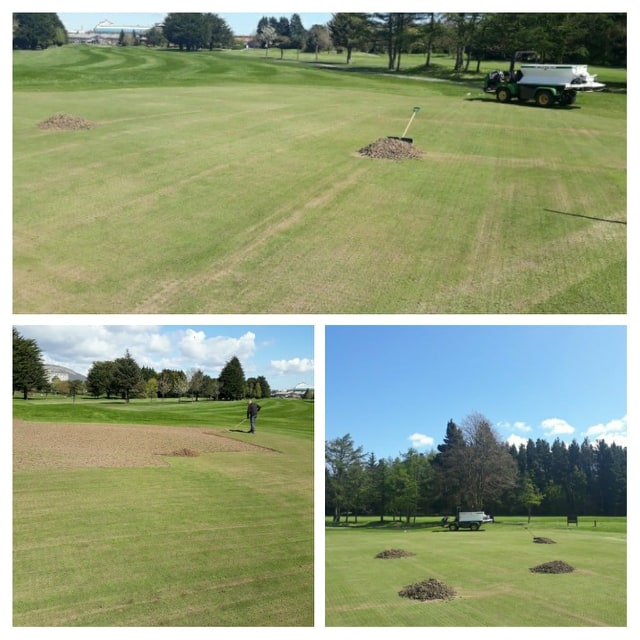Improving soil aeration and decompaction is a huge part of maintaining any turf surface, but especially sports turf surfaces. This can be achieved using a variety of methods including slit or knife tines, soild or spike tines, or hollow tines. Today’s topic is hollow tining (coring). These tines physically remove a core of soil from the turf/soil profile and leave a comparatively large hole. They have a number of beneficial effects, including: Thatch removal – hollow tining at 50mm centers can remove 5% of the thatch from an area of turf. Soil exchange and amelioration – poor soil is removed and replaced with topdressing of the desired material. Relief of soil compaction by removing soil, and the introduction of air into the soil profile; hence also increased water infiltration to name a few. More below.

Hollow tines mainly work to depths of 7mm to 100mm, but come in a range of diameter sizes from 6mm to 25mm. The size influences the spacing used. IGFH suggests spacings as follows:
-Narrow tines 6mm: 25mm spacing
– Medium 12mm tines: 50mm spacing
– Large 25mm tines: 100mm spacing
Using larger diameter tines at close spacing will result in too much of the turf/soil being removed, resulting in a surface that may collapse or cause chunks to be removed.
After hollow tining, it is normal practice to remove the cores and topdress the surface with a suitable mixture of sand/soil. This will vary greatly depending on your site and existing soil.
Other benifits of hollow tining include:
-Improved surface drainage when channels or fissures are created through the soil profile to allow water to infiltrate and move through the soil.
-Improved soil air supply; roots will grow well in the macropores created by aeration tines and will benifit from increased oxygen supply.
-Improved soil texture, especially when topdressing is used after hollow tining.
-Breakdown of thatch and mat will occur because of increased microbial activity resulting from better areated soil.
-Increased drought resistance of the sward because of greater root mass and depth of growth.
-Release of unwanted chemicals and gasses trapped in the soil.
-Unlocks nutrients that the roots previously couldn’t get to.
-Longer growing season due to improved drainage and potentially soil that will remain warmer for longer.

How many times per year does it need doing?
The intensity of any form of hollow coring all depends on what the club, venue or company is trying to achieve. Is there a thatch problem? Are the greens or sports turf surfaces compacted and not draining well after rain, or do we need to remove undesirable soil and replace with a sand top dressing?
How long does it typically take for an area to recover?
The recovery of the greens after this kind of work varies depending on the size of tines and the spacing between them (how much surface area you are trying to impact upon) and obviously the weather conditions following the work. Ideally, weather would be mild with adequate rainfall rather than too cold, too hot or too dry.
When is a good time to hollow tine?
If you ask most greenkeepers when the best time to do this kind of work, they would probably say May to August, as this is when growing
conditions are at the best (UK and Europe) and so any recovery will be quickest. Unfortunately, this is the main playing season for sports like golf, so disruption during this time is undesirable, but for sports such as rugby and football, this timing works out quite well.
